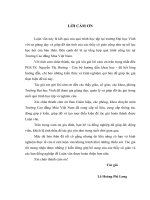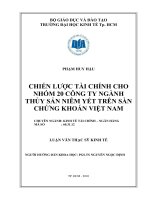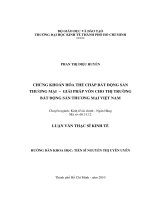Determinants of secondary school dropout in Viet Nam Luận văn thạc sĩ
Bạn đang xem bản rút gọn của tài liệu. Xem và tải ngay bản đầy đủ của tài liệu tại đây (1.11 MB, 96 trang )
MINISTRY OF EDUCATION AND TRAINING
UNIVERSITY OF ECONOMICS, HO CHI MINH CITY
NGO HOANG THAO TRANG
DETERMINANTS OF SECONDARY SCHOOL
DROPOUT IN VIET NAM
MASTER OF PUBLIC POLICY THESIS
HO CHI MINH CITY - 2010
MINISTRY OF EDUCATION AND TRAINING
UNIVERSITY OF ECONOMICS, HO CHI MINH CITY
FULBRIGHT ECONOMICS TEACHING PROGRAME
NGO HOANG THAO TRANG
DETERMINANTS OF SECONDARY SCHOOL
DROPOUT IN VIET NAM
Public Policy Major
Code: 603114
MASTER OF PUBLIC POLICY THESIS
SUPERVISOR
Dr. JONATHAN R. PINCUS
HO CHI MINH CITY - 2010
CERTIFICATION
I certify that the substance of the thesis has not already been submitted for any
degree and is not being currently submitted for any other degrees.
I certify that to the best of my knowledge any help received in preparing the
thesis and all sources used have been acknowledged in the thesis.
The study does not necessarily reflect the views of the Ho Chi Minh City
Economics University or Fulbright Economics Teaching Program.
Author
Ngo Hoang Thao Trang
ACKNOWLEDGEMENTS
I would like to express my deep gratitude to my parents who always encourages
me in my life and my studying.
I would like to express my sincere appreciation to my supervisor, Dr. Jonathan R.
Pincus, who has help me in performing the thesis. With rich knowledge, experience
and enthusiasm, he has effectively contributed to my thesis.
I am graceful to Dr. Nguyen Hoang Bao, Mr. Nguyen Xuan Lam for thoughtful
and valuable comments on the early version of my work.
I would like to thank all teachers in Fulbright Economics Teaching Program, who
have retransmitted a lot of their knowledge and experience to me.
Last but not least, I express my thanks to all of my friends who help and motivate
me in performing the study.
Ngo Hoang Thao Trang
Ho Chi Minh City - May, 2010
ABSTRACT
The study examines the effects of individual, household, community, and
regional level on the dropout behavior of the child in secondary school in Vietnam
by using the logistic regression model. The results of the empirical model
confirmed age, working hours per year, education of parents, regions have large
effects on the probability of leaving school. Meanwhile, household expenditure, the
number of siblings, the proportion of pupils with reduced contributions, the pupil to
teacher ratio, the pupil to classrooms ratio and the proportion of classrooms with
good blackboards have small effects on the probability of leaving school. Therefore,
an effective policy recommendation to reduce the dropout rate in secondary schools
in Vietnam is to focus on investing more human capital in the present generation as
well as supporting the important role of parent in education, reducing working
hours per year of children and concentrating on the Mekong Delta and South East.
Key words: School dropout; secondary school.
ABBREVIATIONS
GSO: General Statistic Office
MOLISA: Ministry Of Labor –Invalids and Social Affairs
VHLSS: Vietnam Household Living Standard Survey
CONTENTS
CHAPTER 1: INTRODUCTION……………………………………….….…… 01
1.1 Problem statement…………………………………………………….….…… 01
1.2 The scope and the purpose of the study….…………………………… ……….02
1.3 Research questions of the study ……………………………………… ………03
1.4 The structure of the study………….………………………………….……… 03
CHAPTER 2: LITERATURE REVIEW…………………………… ………… 04
2.1 Concepts …………………………………………………………… …………04
2.2 Theoretical background ……………………………………………… ……… 05
2.2.1 Demand for education…………………………………………… ……… 05
2.2.2 Education production function………………………………… …………08
2.3 The framework of determinants of the dropout … …… ……………… ……08
2.4 Empirical studies of school leaving in Viet Nam……… …………… ……… 16
2.5 Conclusion …………………………………………………………….……… 19
CHAPTER 3: OVERVIEW OF SECONDARY SCHOOL IN VIET NAM ….20
3.1 Schooling trends and dropouts from secondary school in Vietnam…………….20
3.2 Analyzing opportunities to access secondary school in Vietnam… ……… …23
3.3 Conclusion……………….…. ….……………………………………………….26
CHAPTER 4: METHODOLOGY AND ANALYTICAL
FRAMEWORK…………………………………………………… …………… 27
4.1 Data………… ………………………………………………………………… 27
4.2 Methodology……………………………………………………………… … 28
4.3 Empirical model…………………………………………………………………30
4.4 Variables in the empirical model………………… ………………… ………30
4.5 Conclusion …………………… ……………………………………………….36
CHAPTER 5: ANALYZING DETERMINANTS OF DROPOUT SECONDARY
SCHOOL IN VIETNAM………………………………………………… ………37
5.1 Descriptive statistics………………… ……………………………………… 37
5.2 Regression results………………… ………………………………………… 43
5.3 Interpretation and discussion………………….……………… ……………….45
5.4 Scenario analysis………………………………………………………… ……50
5.5 Conclusion…………….… …………………………………………………… 56
CHAPTER 6: CONCLUSION………… ……………………………………… 57
6.1 Conclusion………… … ………………………………………………………57
6.2 Policy recommendations…………… …………………………………………58
6.3 Limitations of the study.…………………………………………………………60
REFERENCES
APPENDIX
LIST OF TABLES
Table 5.1: Logistic regression of school dropout as a function of selected individual,
household, school and demographic characteristics, and the children sample aged
11-18, VHLSS 2006……………………………………………………………… 43
Table 5.2: Marginal effects of the probability of dropping out…… ……………44
Table 5.3: Predicted dropout probabilty of children by education level of
parents…………………………………………………………………… ……….52
Table 5.4: Predicted probability of dropping out by hours working per
year…………………………………………………………………………………54
Table 5.5: Predicted probability of dropping out by region……………………… 55
LIST OF FIGURES
Figure 3.1: Number of pupils in secondary school in Vietnam from 1999-
2006… 21
Figure 3.2: Secondary education dropout and repeat rate, 1999 – 2004 …… ……22
Figure 3.3 Secondary education dropout and repeat quantities, 1994-2004….… 22
Figure 5.1: Dropout rate in Vietnam in 2006, by gender and by age…………… 38
Figure 5.2: Dropout rate in Vietnam in 2006, by hours working per year…………39
Figure 5.3: Dropout rate in Vietnam in 2006, by household expenditure…………39
Figure 5.4: Dropout rate in Vietnam in 2006, by parent educational level ………40
Figure 5.5: Dropout rate of Vietnam in 2006, by urban and regions………………42
Figure 5.6: Conditional effect plot of dropout probability according to educational
level of parents…………………………………………………………………… 53
Figure 5.7: Conditional effect plot of dropout probability according to hours
working per year………………………………………………………………… 54
Figure 5.8: Conditional effect plot of dropout probability by regions …… ……55
1
CHAPTER 1
INTRODUCTION
1.1 Problem Statement
Education is widely considered as an engine of economic and social
development. The power of schooling is to raise incomes, to increase productivity
and to promote social equity. Therefore, educational expansion at all levels is
important for poor countries and the poor because it is the most powerful instrument
for a society to escape from poverty (World Bank, 1999). The importance of public
investment in education for economic development is shown by the success of the
East Asian economies such as Hong Kong, Singapore and Korea. (Chew et.al.,
1999). Moreover, research on returns to education often finds that returns to the
primary level are highest and returns to secondary level are the second highest
(Psacharopoulos and Anthony, 2002).
Vietnam has recorded achievements in education and developed a
comprehensive education and training system. Nevertheless, Vietnam is facing a
crisis in terms of the quality of education at all levels and a crisis of dropouts of
pupils. For years from 2001 to 2005, more than four million pupils have left school:
more than one million at the primary level, two million at the lower secondary level
and a million at upper secondary level. According to statistics for the first semester
of the year 2008-2009 from the Ministry of Education and Training, among fifteen
million pupils in Vietnam, eighty six thousand have dropped out of school: nine
2
thousand at the primary level, forty thousand at the lower secondary level and thirty
eight thousand at the upper secondary level. The Mekong Delta had the highest
number of dropouts at twenty five thousand. The Central Highlands had eleven
thousand dropouts and the North-West 4,600 dropouts. The consequence of pupils
dropping out include private and public costs. For individuals, they cannot get
skilled employment so they earn little money and face many risks and
discrimination in society. For the country, dropouts reduce the rate of growth of the
skilled labor force. Moreover, dropouts make the gap between the poor and the rich
larger.
Motivated by this situation, this study analyzes the determinants of the dropout
rate from secondary school in Vietnam. The contribution of the study is to find out
which factors influence the dropout rate and to suggest policies to reduce it.
1.2 The scope and the purpose of the study
The study focuses on analyzing empirically factors that affect dropout behavior
of children at the individual, household and school level. The analysis is carried out
on the case of dropouts from the secondary level in Vietnam in 2006. The study
aims at identifying the degree of impact of factors affecting the dropout rate from
secondary school. The study provides input for policy makers formulating policies
to reduce the dropout rate at the secondary level in Vietnam.
3
1.3 Research questions of the study
The study attempts to answer the central question: What are the most prominent
factors affecting secondary school dropouts in Vietnam?.
In order to answer the central question, some following sub –questions should
be addressed:
What are the factors theoretically affecting dropouts?
To what extent do these factors explain dropouts at the secondary level in
Vietnam?
What should be done to reduce dropouts from secondary school in Vietnam?
1.4 The structure of the study
The study consists of six chapters. Following this introduction, the rest of the
study is structured as follows. Chapter 2 is devoted to the literature review in order
to provide the analytical framework for the thesis. It will present concepts, discuss
the theoretical background, and then lay out a framework for studying the
determinant of school dropouts and review empirical studies concerning dropouts in
Vietnam. Chapter 3 is an overview of secondary schools in Vietnam. The
methodology and empirical model are presented in Chapter 4. It will describe the
dataset, set up the methodology, explain the empirical model and describe the
variables used. Chapter 5 reports and discusses the empirical results of the model.
Chapter 6 concludes the study with a summary of the main findings and policy
recommendations. It also includes some remarks on the limitations of the study.
4
CHAPTER 2
LITERATURE REVIEW
Chapter 2 provides a review of the conceptual, theoretical and empirical studies
of the dropout behavior of children. This chapter starts its journey with the concept
of school dropouts. Next, it lays out the theoretical background on educational
demand at the individual level and the household level. Then it presents a survey of
the literature on key dropout factors. It discusses empirical studies in Vietnam in
order to show the effects of such factors on dropouts.
2.1 Concepts
As a first step, it is useful to provide the concept of school dropouts used in the
study. According to MOET, a child is viewed as a dropout if he or she did not
continue his or her schooling. Vo Tri Thanh and Trinh Quang Long (2005) criticize
this definition since it does not count those who do not continue to enroll in school
after having finished a given grade. This may lead to an underestimation of school
dropouts. In the study, a child is a dropout if he or she has not completely enrolled
in school in the twelve months prior to the survey, given that he or she used to
enroll in school sometime before.
5
2.2 Theoretical background
This sub section is devoted to a review of the main literature relating to
investment in education on the demand and supply sides. Then it discusses factors
affecting dropouts in recent empirical studies. The subsection is not intended as a
complete and extensive review, it merely sets the stage by presenting relevant
considerations.
2.2.1 Demand for education
An elegant theoretical framework regarding determinants of the optimal length
of education has evolved from the human capital theory of Becker (1967) and Ben-
Porath (1967) [cited in Ranasinghe (1999)] . Human capital theory argues that
additional schooling generates benefits in terms of enhanced future earnings and
entails direct costs such as expenditures on school tuition and opportunity costs
associated with delayed entry into the labor market. The individuals will compare
the direct and the opportunity costs of schooling with its future benefits. The
investment will continue so long as the marginal rate of return to additional
schooling equals the marginal rate of the cost of education. According to the theory
of Becker (1967), differences in the length of schooling may be due to differences
in the discount rate or due to differences in the rate of return to education or the
covariance between the two. People with lower discount rates (and low costs) and
those with higher rates of return will stay longer in school than others do. Another
schooling model developed in the spirit of Becker is Ben-Porath (1967). Ben –
Porath (1967) takes into consideration the dynamic nature of human capital
6
formation to develop his model. In general, the human capital models of Becker
(1967) and Ben-Porath (1967) generate similar testable hypotheses regarding the
demand for education. However, in the Ben-Porath model (1967), some particular
features are different from the Becker model. Ben-Porath (1967) posits a direct role
for age whereas Becker (1967) does not included age as a determinant of the
equilibrium length of school. Next, the role of ability and family wealth is also
different in the two models. According to Becker (1967), ability affects the rate of
return. More able people stay longer in full time education because they have a
higher rate of return. However, according to Ben-Porath (1967), ability affects
duration through costs.
The human capital theory of Becker (1967) and Ben-Porath (1967), however,
implicitly assumes no resource constraints. This assumption does not hold in the
real world. Therefore, resource constraints place a limit on the amount of resources
that can be allocated within a household. In household schooling decisions, parents
are viewed as the principal and children are viewed as agents. Parents can view
education as both a consumption and an investment good so parents decide the
education level of their children to maximize their utility. According to the model of
household decision making regarding investments in education of boys and girls
(Glick and David, 1998), parents are considered to live over two periods. In the
first period, they earn money spending; feeding their children and spending money
for their children to go to school. Consumption in the first period includes personal
spending and spending on the education of children. In the second period, the
7
consumption of parents will depend on remittances from their children.
Nevertheless, remittances from their children depends on the returns on educational
investments of their children as well as their specific characteristics. Parents will
choose the duration of their children’s education to maximize their utility subject to
income, time constraints for the household members and the earnings of the
production function for each child. The limitation of household models is that
preferences of parents for their children are identical. To overcome the limitation of
the model, bargaining models assume that parents have different preferences for
their education of sons and for that of boys leads to gender specific demand
functions for schooling. Differential preferences may be a response to the actual or
perceived differences in the labor market returns to female and male schooling
(Patton, 1993) [cited in Chu Bao Hiep (2008)].
In the study, human capital models are embedded into a model of household
demand where both parents and the individual child are decision makers. This
framework captures the close economic interdependence between the child and the
family. The basic implication of such a framework is that the decision to attend
school depends not only on market forces and public programs that determine the
costs and benefits of education, but also on the preferences of the family, resource
constraints and alternative uses of the time of children in non-school activities, such
as work or leisure.
8
2.2.2 Education production functions
The human capital theories and household schooling decision models assume that
schools are homogenous. In practice, schools are different from each other in
productivity. A systematic investigation of the relationship between school inputs
and the output of pupils is condensed in the education production function. An
education production function assumes that the optimal learning process in
schooling can be approximated by production theory. Inputs into the education
production process include school inputs, peer groups inputs and inputs of
individual pupils. The outputs of the education production process are expressed as
a single dimension or multiple dimensions. The empirical estimates of the education
production function choose a single output as the dependent variable. Polacheck et
al. (1978) [cited in Ranasinghe (1999)] use exam scores as the output of pupils,
Card and Krueger (1992a and 1992b) [cited in Ranasinghe (1999)] use labor
market returns and Mora (1997) [cited in Ranasinghe (1999)] use school dropout
decisions. Furthermore, [Chizmar and Zak (1983), (1984) and Chizmar and
McCarney (1984), cited in Athula Ranasinghe (1999)] choose more than one
output at the same time sharing the given amount of inputs.
2.3 The framework of determinants of school dropouts
Now that the common theoretical framework is already established, there is a
need to know more specifically about the determinants of school dropouts. These
determinants are organized into four groups and each determinant impacts
positively, negatively or both on the probability of dropping out. Each determinant
9
is individually considered through the presentation of the most relevant results in
theories and in empirical studies.
Group 1: Individual characteristics
Gender
This subsection deals with the relationship between gender and school dropouts.
On this point, there is a consensus that gender inequality affects the dropout rate of
boys and girls. One line of reasoning is that parents predict that the returns to the
education of boys is higher than girls (Schultz, 1993). In the labor market, girls may
be discriminated against in terms of earning, so the future earnings of girls are
lower than that of boys. This means that monetary benefits to invest in education for
girls may be lower than for boys. Moreover, even if educated girls receive earnings
on a par with men, income remittances to parents from married women may be
lower than married men. Another line of reasoning is that the opportunity cost of
educating girls is higher than for boys. Girls in developing countries and in rural
areas have to perform more domestic responsibilities than boys, reflecting cultural
or social attitudes toward the proper economic role of women and girls. This means
that the marginal cost of time of girls may be higher than that of boys and
consequently the demand for their schooling will be lower (Glick and David 1998).
Furthermore, girls have a higher probability of dropout if budgets of parents are
constrained (Deaton, 1989).
On the other hand, gender disparities in education are different between
countries. According to Filmer (2006) girls are at a great educational disadvantage
10
in particular regions such as South Asia and North, Western, and Central Africa,
especially in poorer households. At the other extreme there are countries, mostly in
Latin America, where there is no female disadvantage, and often a small female
advantage in education.
Age
This subsection focuses on the effect of age on dropouts. On this point, there is
a consensus that the age of the child has a positive impact on the probability of
dropout. According to Ben-Porath (1967) [cited in Ranasinghe (1999)], high
opportunity costs and lower marginal benefits for older children discourage parents
from investing in full time education for their children. At the working age, children
may enter the labor force to help their parents. Moreover, higher costs of school
fees at higher levels may be a constraint on enrollments of children.
Child work
This subsection is concerned about whether the dropout rate is related to the
working status of the child. Many studies explain factors affecting child labor
participation and the relationship between dropout decisions and work. Most
researchers find a positive relationship between school dropout and child labor
participation. According to Admassie (2002), child employment interferes with
schooling by absorbing too much time of the child. Work also requires a lot of
energy so that children cannot have the necessary energy for school attendance or
for effective studying. Even for those children who might be able to combine farm
work or domestic work with schooling, long hours of work will leave them
11
exhausted. Suffering from fatigue, these children will have very little mental
stimulation, the results of which will be neglect of their studies.
Group 2: Household characteristics
Education of parents
The educational level of parents is considered as an important factor affecting
the dropout rate of children. Extensive empirical studies have provided universal
support for the above argument. The empirical study of Glick and Sahn (1998)
supported the negative relationship between the educational level of parents and the
dropout probability. They argue that educated parents are more likely to recognize
the benefits of schooling than less educated parents. Moreover, educated parents are
more able to assist in the learning of their children than less educated parents.
On the other hand, there is evidence that the effects of parents’ educational
attainment is different between boys and girls. According to Tansel (1997) an
increase in the schooling years of parents decreases the probability of a child
dropping out. Moreover, he found that there are differential effects for boys and
girls. The effects of the educational level of both mother and father on the
probability of a daughter dropping out was larger than on sons except for the
education of the mother at the primary level. This may be due to several reasons. It
is possible that relatively uneducated parents tend to be in locations where there are
some barriers to the school attendance of girls. It is also possible that the education
of parents has a big effect on their attitudes towards girls’ schooling.
12
Household income
Like education of parents, the negative relationship between income and the
probability of dropping out is strongly supported by theoretical as well as empirical
studies. According to Glick and Sahn (1998), wealthier household are likely to be
able to pay for schooling out of current income or savings and have easier access to
credit. Children from such households are expected to be more likely to enroll and
to stay in school longer. Otherwise, poor households may be unable to afford the
direct or indirect costs of schooling and are constrained in their ability to borrow to
cover the costs. Moreover, richer household can invest in the education of children
by tutoring at home or improving the health of children, thus increasing demand for
schooling (Le Van Chon, 2000).
On the other hand, short run income
income variability affects child labor and
schooling in developing countries.
According to Duryea, et al. (2006), an
unemployment shock (like job loss) significantly increases the probability that a
child enters the labor force, drops out of school, and fails to advance in school. This
result suggests that some households are not able to absorb short-run economic
shocks, with negative consequences for children.
Number of children
This subsection focuses on the relationship between the number of children in the
household and the probability of dropout. Most studies find a positive relationship
in developing countries, including Peru and Brazil (Psacharopoulos and Arriagada,
1989). The number of children increases the probability of dropout because of
13
budget constraints on households. Moreover, according to Parish and Willis (1993)
girls more are more likely to dropout than boys because an increase in the number
of very young children may raise the demand for the labor of girls in childcare in
the home.
However, Chernichovsky (1985) argued that the tradeoff between child
schooling and the number of children is rejected by the data he analyzed. He found
that means that the number of children in a household has a negative effect on child
dropouts in Botswana. Chernichovsky (1985) argued that role assignment in the
household permits “specialization”, so that some children are assigned household
and farm activities, while others are sent to school and concentrate on this activity.
Group 3: School characteristics
School fees
School fees are considered as an important factor affecting the probability of
dropout. Many theoretical and empirical studies form a consensus on this issue.
Becker (1975) [cited in Ranasinghe (1999)] argues that whether a child goes to
school depends on a comparison between future benefits of the human capital of the
child and the direct and opportunity costs of schooling. So higher costs of schooling
increase the probability of dropout. Most empirical research concludes that school
characteristics related to costs and benefits influence enrollment and attainment of
children (Al-Samarrai & Peasgood, 1998; Chernichovsky, 1985; Dostie &
Jayaraman, 2006; Wolfe & Behrman, 1984; Zimmerman, 2001). Furthermore,
Glewwe and Patrinos (1999) state that if school fees are excluded from models of
14
determinants of school dropouts, it would limit our understanding of family
decision making on investing in education. He concluded that high costs keep some
children out of school and this is particularly important for countries where free
education is limited by resource constraints.
School quality
This subsection focuses on dealing with the connection between school quality
(infrastructure and teacher qualifications) and dropouts. There have been
inconclusive results in the empirical literature. No consensus has been reached on
the direction of the connection as many theoretical and empirical studies provide
contradictory arguments and evidence. Coleman (1966) [cited in Kain and Singleton
(1996)] report that school inputs such as class size, teacher quality and
infrastructure have a marginal influence on the achievement of pupils. A study in
China concluded that community resources and school provisions reinforced
transmission of background effects from parents to children, due to effects of school
availability and quality (Hanum, 2003). Other studies in developing countries have
also reported that common causes of inequality in educational opportunities were
regional differences and school availability, expenses, and quality, as measured by
such factors as student–teacher ratios, teacher qualifications, and school fees and
contributions. These inequalities influence not only the probability of dropout but
also test scores of pupils. Similar research, including Brown & Park (2002), has
found that school quality contributed positively to enrollment decisions, but not to
learning outcomes in rural China. Moreover, Oakland (1986a &1986b) emphasizes
15
that strong and influential administrative and instructional leadership enhances
school effectiveness. Principals in schools with lower drop out rates tend to provide
stronger leadership and to use their staff more effectively. Stronger leadership is
evident in their ability to communicate expectations for and their enforcement of
student and teacher discipline, in their management style, and in their formulation
of clear educational mission statements for the school that include the belief that all
students are capable of displaying academic success.
However, Hanushek (1986) [cited in Ranasinghe (1999)] argued that although
school inputs such as teacher to pupils ratios, teacher education, teacher experience,
teacher salaries, expenditure per pupil and selected administrative and physical
facility variables are presumed to have a positive effect on the school output, these
variables are statistically insignificant and there are many cases where the
regression coefficients are negative. This finding is rather similar for both
developed and developing countries. Loeb and Bound (1966) [cited in Athula
Ranasinghe (1999)], through an extensive review of the literature, have observed
that, in general, school inputs are significant when the labor market variables are
used as the education output, whereas they are insignificant when academic
outcomes are used as the education output.
Group 4: Regional characteristics
Demographic differences
This subsection examines the relationship between dropping out of school and
demographic differences. They are suggested as factors affecting dropout of









